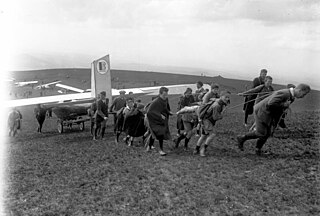The Dart Cambridge was a single-seat competition sailplane built in the United Kingdom in the 1930s. A development of the Grunau Baby, only two were built, flying with gliding clubs.

The Akaflieg Darmstadt D-7 Margarete, often shortened to Darmstadt D-7 Margarete, was one of the earliest two seat monoplane gliders, designed and built by German university students in 1923.

The Akaflieg Darmstadt D-9 Konsul, often shortened to Darmstadt D-9 Konsul, was a high performance, single seat, cantilever monoplane sailplane, designed and built by a German University student group in 1923 for hill soaring.
The Akaflieg Darmstadt D-28 Windspiel was a single-seat, high-performance sailplane designed in Germany in the early 1930s. Intended to exploit a growing understanding of thermal soaring, it was small and manoeuvrable, with a 12 m span; silk-covered for lightness, it weighed less (empty) than its pilots. It held the world straight-line distance record for a time in 1934.
The LCF II is a single seat Club Class glider, designed and built in the 1970s by German glider club members and intended to be suitable for training, competition and in particular aerobatics. Only one was completed.
The CVV 2 Asiago is a simple, single seat glider designed and built in Italy in the mid-1930s, the second of a series of gliders from the Milan Polytechnic and the first go into production.

The CVV 8 Bonaventura was a two-seat competition glider designed and built in Italy during the 1950s. Fifteen were produced.
The Bonomi BS.14 Astore was a two-seat training and aerobatic glider, designed and built in Italy in 1935. Only one was constructed.
The Pagliani Vittoria was a single-seat glider built in Italy during Second World War. Only one was constructed.
The CVT1 Zigilo was a single-seat, 12 m (39 ft) span Italian training glider designed and built in Italy in the 1950s. Only one was completed.
The Teichfuss Sparviero was an Italian single seat aerobatic glider, designed by Luigi Teichfuss and flown in 1938.
The IIL IS-11 was an aerobatic, single seat glider, designed and built in Romania in 1959. It was built in small numbers.
The RRG Professor was a very early soaring glider and the first to use a variometer for finding thermals. It was designed by Alexander Lippisch in Germany, first flying in 1928. The Professor was widely built by both flying clubs and factories.
The Schneider Grunau 8 was a simple, two-seat trainer glider designed and built in Germany in the early 1930s.
The Schneider ES49 is a two seat glider trainer, designed, first flown in late August 1951 and commercially produced in Germany but later built from plans by gliding clubs in Australia. A major redesign there led to the ES49B Kangaroo.
The Czerwiński CW 7 was a Polish aerobatic glider first flown in 1934. Despite a structural weakness that prevented inverted flight, a small batch of CW 7s were used by several aeroclubs until the start of World War II.
The Warsztaty Szybowcowe Sokół was a 1930s Polish aerobatic sailplane. Ten were built and flown by Polish aeroclubs, participating in national and international events, until the outbreak of the Second World War.

The Rubik R-03 Szittya I was a Hungarian single-seat sailplane flown in the late 1930s. The design was developed through three improving variants. though only one of each was built.
The Jancsó-Szokolay M22 was a Hungarian single-seat sailplane first flown in 1937. Twenty were built and the type set several national records. Some remained in service up to about 1953.
The Rubik R-17 Móka (Joy) was a Hungarian aerobatic glider designed in the late 1930s. One prototype was built and first flown in 1944 but was destroyed near the end of World War II. Two more, with modified ailerons and a new fuselage, were built in 1950 but were abandoned after a fatal accident.















